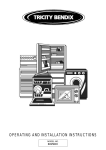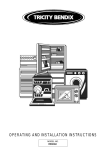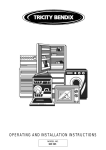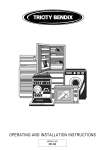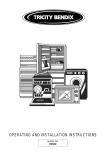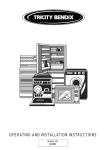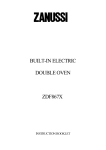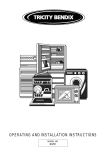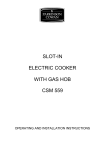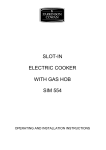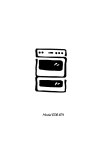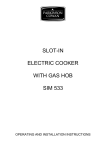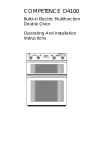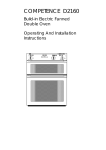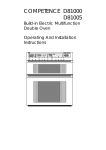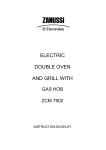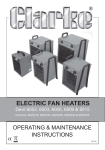Download Electrolux U03059 User's Manual
Transcript
SLOT-IN ELECTRIC COOKER WITH GAS HOB Owners handbook and Installation instructions 27 IMPORTANT SAFETY INFORMATION These warnings are provided in the interests of your safety. Ensure that you understand them all before installing or using the cooker. Your safety is of paramount importance. If you are unsure about any of the information in this book contact the Customer Care Department. Telephone 0870 5 950950. l Always stand back from the cooker when INSTALLATION opening the oven door to allow any build up of steam or heat to release. l The cooker must be installed according to l Do not place sealed cans or aerosols inside the instructions supplied. The installation the oven. They may explode if they are work must be undertaken by a competent heated. person as stated in the gas safety l Ensure that all control knobs are in the OFF (Installation & Use) regulations current position when not in use. edition. l Do not stand on the open oven doors. l It is important that the cooker is suitable for l Do not hang towels, dishcloths or clothes your gas supply. Your installer should check from the cooker or its handles. the data badge. l The cooker must be installed in an CLEANING AND MAINTENANCE adequately ventilated room. l Do not leave cookware containing l This cooker is heavy and care must be taken foodstuffs, e.g. fat or oil in the cooker in when moving it. Do not try to move the case it is inadvertently switched on. cooker by pulling the door handles. l This cooker should be kept clean at all l All packaging, both inside and outside the times. A build-up of fats or other foodstuffs cooker must be removed before the cooker could result in a fire, especially in the grill is used. pan. l Do not stand on the cooker or on the open l Do not disconnect the cooker from the gas oven doors. supply if the supply pipe does not have l It is dangerous to alter the specifications or bayonet connection as described in the modify the cooker in any way. installation section. If this is the case contact CHILD SAFETY the person who installed the cooker. l Only clean this cooker in accordance with l This cooker is designed to be operated by the instructions given in this book. adults. Young children must not be allowed l Always switch off the electric supply before to tamper with the controls or play near or cleaning the cooker. with the cooker. l The cooker and accessible parts especially AT THE END OF THE COOKERS LIFE around the grill area become hot when the l When the time comes to dispose of your cooker is in use. cooker please contact your local Council DURING USE Authority. They can arrange to dispose of the cooker in a safe and controlled manner. l Do not use this cooker if it is in contact with The number will be in the telephone book. water. Never operate it with wet hands. l Take great care when heating fats and oils as they will ignite if they become too hot. Please read this l When you are lighting any burner check that instruction book carefully it is lit before you leave the cooker. When before use and retain turning off a burner, do not leave the cooker for future reference. until the flame has gone out. l Always use oven gloves to remove and place food in the oven. To help you the following symbols will be found in the l Ensure that the vents at the top of the oven text. are not obstructed to ensure ventilation of the oven cavity. l Never line any part of the cooker with Safety Instructions aluminium foil. l Do not allow heatproof cooking material, e.g. roasting bags to come into contact with oven Step by Step Instructions elements because they may catch fire. Hints and Tips 2 CONTENTS FOR THE USER Important Safety Information Description of the Cooker Rating Plate Getting to Know Your Cooker Control Panel The Cooling Fan for the Controls Control Panel Indicator Neons Before Using The Cooker Location Preparing to use your Cooker When First Switching On Grill and Oven Furniture 2 4 4 5 5 5 5 6 6 6 6 7 The Clock and Automatic Timer 8 The Gas Hob To Light the Hob Burners Things to Note Hints & Tips 11 11 12 12 The Dual Grill Uses of the Grill How To Use the Dual Grill Things To Note The Grill Pan and Handle Hints and Tips Grilling Chart 13 13 13 13 14 14 16 The Top Oven / Plate Warmer Uses of the Top Oven How To Use the Top Oven Things To Note To Fit the Oven Shelf Hints and Tips Oven Cooking Chart To Use the Plate Warmer Things To Note 17 17 17 17 17 18 19 20 20 The Ultra Fan Ovens Uses of the Ultra Fan Oven How To Use the Ultra Fan Oven Things to Note To Fit the Fan Oven Shelves Hints and Tips 21 21 21 21 22 22 Ultra Fan Oven Cooking Chart Roasting Chart 23 24 Defrost and Cooling Function How To Defrost / Cool Things to Note Hints and Tips 25 25 25 25 General Hints & Tips Condensation & Steam Cookware The Trivet Cooking to Reduce Soilage 26 26 26 26 26 Care and Cleaning Cleaning Materials Cleaning the Hob Hints & Tips Replacing the Hob Burner Parts Cleaning the Outside of the Cooker Moving the Cooker Cleaning the Outer and Inner Door Glass Panels Cleaning Inside the Ovens / Grill To Remove the Wirework Runners Cleaning the Shelves, Wirework Runners and Oven Furniture Care of Stayclean Surfaces The Oven Cleaning Cycle Things to Note Hints and Tips Replacing an Oven Light Bulb 27 27 27 28 29 29 30 If Something Doesn't Work Guarantee Conditions Service and Spare Parts Customer Service Centres 34 36 37 38 30 31 32 32 32 32 33 33 33 FOR THE INSTALLER Technical Details Things You Need to Know Warnings Choice of Electrical Connection Things to Note Safety Requirements / Ventilation Location of Appliance Connecting to the Mains Terminal Connecting to Gas Fitting the Stability Bracket Testing 40 41 41 41 41 42 43 44 45 46 47 3 DESCRIPTION OF THE COOKER Slot in electric cooker with gas hob Gas Hob Hob Controls Dual Grill Clock and Automatic Timer for left hand Ultra Fan Oven Control Panel Top Oven / Plate Warming Compartment Rating Plate Ultra Fan Oven Ultra Fan Oven Plinth The cooker has a separate dual grill compartment, a conventional electric top oven and plate warming compartment and two large fan ovens. The left hand fan oven can be automatically controlled by the timer. The gas hob with five burners is fitted with automatic ignition. RATING PLATE The model, product and serial numbers of your cooker are recorded on the back page of this instruction book for future reference. You can also find these numbers on the rating plate on the front frame of the cooker upon opening the grill door. The cooker must be protected by a suitably rated fuse or circuit breaker. The rating of the cooker is given on the rating plate. Do not remove the rating plate from the cooker as this may invalidate the guarantee. 4 GETTING TO KNOW YOUR COOKER The Control Panel Clock / Automatic Timer Grill Indicator Neon Dual Grill Control Ultra Fan Oven Temperature Control Plate Warming / Top Oven Indicator Neon Plate Warming / Top Oven Temperature Control Ultra Fan Oven Indicator Neon Ultra Fan Oven Temperature Control THE COOLING FAN FOR THE CONTROLS Your cooker has a cooling fan fitted behind the controls. The cooling fan will come on immediately when the grill or ovens are switched on. CONTROL PANEL INDICATOR NEONS The neons indicate whether the ovens or grill are switched on. In the case of the ovens, the neons remain on until the set temperature is reached. They will turn on and off to show that the temperature is being maintained. The grill neon glows when the grill is in use. The Ultra Fan oven neons do not glow with the Defrost setting. If the neons do not operate as the instructions indicate the controls may have been incorrectly set. Return all controls to zero and re-set following the instructions for the required setting. 5 BEFORE USING THE COOKER LOCATION The room the cooker is fitted in must have a good air supply that meets the standard BS 5440 Part 2 (current edition). The cooker may be placed in a kitchen, kitchen/diner or bedsit but not in a bathroom or shower room. It should not be installed in a bedsit smaller than 20m3. L.P.G. cookers MUST NOT be installed below ground level, i.e. in a basement, or aboard any boat, yacht or other vessel. The use of a gas cooking appliance results in the production of heat and moisture in the room in which it is installed. Ensure that the kitchen is well ventilated: keep natural ventilation holes open or install a mechanical ventilation device (mechanical extractor hood). Prolonged intensive use of the appliance may call for additional ventilation, for example opening of a window, or more effective ventilation, for example increasing the level of mechanical ventilation where present. PREPARING TO USE YOUR COOKER Wipe over the base of the ovens with a soft cloth and hot soapy water and wash the grill and oven furniture before use. We suggest that you run the oven elements for 10 - 15 minutes at 220°C to burn off any residue from their surfaces. The procedure should be repeated with the grill for approximately 5 - 10 minutes. During this period an odour may be emitted, it is therefore advisable to open a window for ventilation. WHEN FIRST SWITCHING ON The Top Oven, Dual Grill and right hand Ultra fan oven are not controlled by the automatic timer. If the left hand Ultra fan oven indicator neon does not glow when the controls are switched on, it is most likely that the timer is set for automatic cooking. 6 GRILL AND OVEN FURNITURE The following items of oven furniture have been supplied with the cooker. 1 grill pan 1 plate rack 1 grill pan handle 1 grill deflector 1 grill pan grid 2 trivets 2 meat tins 4 shelves for Ultra Fan oven cooking (Two per oven) 1 grill shelf 1 Top oven shelf The grill deflector sits above the grill element and prevents fat splashing onto the grill roof. The deflector may be easily removed for cleaning. Scuffing of the Stayclean sides and back panel by the oven furniture pack may occur during transit. These marks will disappear after the oven has been used for the first time. 7 THE CLOCK AND AUTOMATIC TIMER A CLOCK / COOK TIME SETTING KNOB B START TIME SETTING KNOB C SECOND HAND (RED) D START TIME INDICATOR (GREEN) E HOUR HAND (GOLD) F MINUTE HAND (GOLD) G DISPLAY WINDOW H MANUAL SYMBOL ( F B START C A H G E ) The clock will operate when the cooker is switched ON at the wall. The clock can indicate the time of day, operate as a minute minder and automatically time the left hand Ultra Fan oven. CLOCK COOK TIME D START TO SET THE TIME OF DAY A 1. To set the time of day, pull out and turn setting knob (A) clockwise until the right time of day is displayed, e.g. 9 a.m. as Fig. 1. TO SET TO MANUAL Fig. 1 1. Ensure the time of day has been set as above. START 2. Push in and turn setting knob (B) in either direction until the green start time indicator lines up with the hour hand of the clock. B 3. Push in and turn setting knob (A) clockwise until the manual symbol ( ) can be seen in the display window as Fig. 2. 4. The left hand Ultra fan oven temperature control can now be used as required. The oven indicator neon will glow. A Fig. 2 TO SET THE MINUTE MINDER 1. Turn setting knob (A) clockwise, without pulling it out. The selected minutes can be seen in the display window e.g. 80 minutes as Fig. 3. A period of up to 3 hours can be timed using the minute minder. The minute minder cannot be used when an automatic programme has been set on the oven timer. At the end of the set time a continuous buzzer will sound for up to 6 minutes. The oven will turn off. 8 CLOCK COOK TIME CLOCK COOK TIME START A Fig. 3 CLOCK COOK TIME TO CANCEL MINUTE MINDER START 1. Turn setting knob (A) clockwise, without pulling it out until the manual symbol( ) appears in the display window as Fig. 4. TO SWITCH THE OVEN ON AND OFF AUTOMATICALLY Note: Only the left hand Ultra fan oven can be set for automatic cooking. 1) Ensure the clock shows the correct time of day and the cooker is set to manual. A CLOCK COOK TIME Fig. 4 START 2) Place food in the left hand Ultra fan oven. 3) To set the length of cooking time required, turn setting knob (A) clockwise, without pulling it out, until the required cooking period can be seen in the display window e.g. 160 minutes (2 hours 40 minutes) as Fig. 5. A Fig. 5 4) Set the start time, by pushing in and turning setting knob (B) in either direction until the green start timer indicator lines up with the time you want the food to start cooking e.g. 1.30 p.m. as Fig. 6 5) Turn the left hand Ultra fan oven temperature control to the required setting. The oven indicator neon should be OFF. START B Fig. 6 When automatic cooking starts the oven neon will remain on whilst reaching temperature and will then turn ON and OFF showing that the oven temperature is being maintained. 6) The green start time indicator will move with the hour hand of the clock until the length of cooking time is complete. A buzzer will sound which can be cancelled by turning setting knob (A) clockwise without pulling it out until the manual symbol appears in the display window. See Fig. 7. The maximum cooking automatic is 3 hours. time CLOCK COOK TIME CLOCK COOK TIME START Fig. 7 CLOCK COOK TIME on 9 TO SET THE TIMER TO SWITCH OFF ONLY START Note: Only the left hand Ultra fan oven can be set to automatically switch off. 1) Ensure the clock shows the correct time of day and the cooker is set to manual. A 2) Place food in the left hand Ultra fan oven. CLOCK COOK TIME Fig. 8 3) To set the length of time you want the food to cook; turn setting knob (A) clockwise, without pulling it out, until the required cooking period can be seen in the display window e.g. 120 minutes (2 hours) as Fig. 8. 4) Turn the left hand Ultra fan oven temperature control to the required setting. The oven neon will glow. The oven neon will remain on whilst reaching temperature and will turn ON and OFF during cooking showing that the oven temperature is being maintained. 5) The green start timer indicator will move with the hour hand of the clock until the length of cooking time is complete. The oven will switch off and a buzzer will sound which can be cancelled by turning the setting knob (A) clockwise without pulling it out until the manual symbol appears in the display window. START RETURNING THE COOKER TO MANUAL OR TO CANCEL AN AUTOMATIC PROGRAMME B A 1. Turn the left hand Ultra fan oven temperature control OFF. Ensure the green start time indicator lines up with the hour hand of the clock by pushing in and turning in either direction, setting knob (B) as Fig. 9. 2. Turn setting knob (A) until the manual symbol ( ) is visible in the display window. Turn the left hand Ultra fan oven temperature control ON to check that the oven operates manually. The oven neon will glow. THINGS TO NOTE The delay time plus the cooking time MUST not exceed 11 hours 59 minutes. 10 Fig.9 CLOCK COOK TIME THE GAS HOB CAUTION: DO NOT USE THE COOKER IF THE HOB GLASS IS DAMAGED. IF A FAULT OR CRACK BECOMES VISIBLE DURING COOKING, DISCONNECT THE COOKER IMMEDIATELY FROM THE ELECTRICITY SUPPLY AND CONTACT THE CUSTOMER SERVICE CENTRE. USES OF THE HOB The gas hob has four different burner sizes to suit different types of cooking: To ensure maximum burner efficiency only use pots and pans with flat bases appropriate to the burner size used. Burner Minimum Pan Size Maximum Pan Size Ultra Rapid 160mm (6½") 300mm (11½") Rapid 100mm (4") 200mm (8") Normal 100mm (4") 200mm (8") Simmer 100mm (4") 200mm (8") Ensure the pan supports correctly fitted before using the hob. See page 29. HOW BURNERS TO LIGHT THE are HOB The hob ignition works by means of an electric spark system. 1. Push in and turn the control knob to the left to the highest setting. This is shown by a large flame symbol. 2. When the burner has lit release the control and adjust the setting as required. Place pans on the centre of the burners. Position pans so the handles cannot be accidentally knocked or overhang the appliance. Lift pans on and off the pan supports. Do not slide them across the hob. TO TURN OFF ANY BURNER 1. Turn the control knob to the off position. This is shown by a large dot. When lighting any burner, ensure that it is lit before you leave the cooker. When turning off a burner, ensure the flame has gone out before leaving the cooker. 11 THINGS TO NOTE If you are having any difficulty lighting a hob burner turn all the hob controls off and make sure the burner parts have been replaced correctly. See page 29 for more information. HINTS AND TIPS Keep flames under the base of pans. If the flames lick round the sides of the pan you are wasting gas. Do not overfill pans or they will boil over. Do not leave accidental spillage on the hob or removable parts. The spillage should be wiped up and the parts washed and carefully dried as soon as the hob, pan supports and burner parts are cool enough to touch. See pages 27 and 28 for full cleaning instructions. Cover pans with a lid whenever possible. Food will heat up more quickly and there will be less steam in the kitchen. A flat based Wok will stand stable on the pan supports. If you use a round based Wok with a collar support, the collar must be the open wirework type otherwise the performance of the burner will be affected. Take care to avoid burns and scalds when reaching across the hotplate. Take extra care when deep fat frying, do not cover the pan with a lid. Do not leave a pan unattended. If the pan catches fire, leave it where it is and turn off all controls. Place a damp cloth or a fitting lid over the pan to smother the flames. Never put water on the fire. Leave to cool for 30 minutes. 12 THE DUAL GRILL WARNING - Accessible parts become hot when the grill is in use. Keep children away. USES OF THE GRILL The grill is in the top left compartment. The whole area of the grill or just the centre section can be used according to the amount of food to be cooked. HOW TO USE THE DUAL GRILL 1. Open the Grill door. 2. Turn the grill control clockwise for Full Grill or anticlockwise for the centre section only. The grill door must be left open when grilling. THINGS TO NOTE When the Full Grill is used, the outer section of the grill element normally glows brighter than the inner section. The grill indicator neon will glow when the grill is switched on. We recommend you use the grill pan on shelves 3 or 5. If you use the grill pan in position 3 the shelf must be withdrawn before the pan can be located or removed. The cooling fan for the controls will operate as soon as the grill control is turned. 5 4 3 2 1 Ensure the grill pan is properly located. After grilling ensure bakeware and the shelf are positioned correctly before closing the door. Persistent contact with furniture and door glass may damage the door. 13 THE GRILL PAN AND HANDLE The grill pan has a removable handle. 1. To insert the handle, press the button on the handle with the thumb. 2. Pivot the handle slightly upwards inserting the lip into widest part of the bracket. 3. Move the handle towards the left, lower into position and release the button. Ensure the handle is positively located. 1. To remove the handle, press the button on the handle with the thumb. 2. Pivot the handle slightly upwards and towards the right to remove from the bracket. Protect your hands when removing the grill pan handle. Always remove the grill pan handle during grilling. To correctly locate the grill pan on the shelf, ensure that the cut out on the underside of the handle bracket locates over the front bar of the shelf. To check the progress of the food being grilled, the grill pan should be withdrawn on the shelf to attend to food during cooking. Ensure that you support the grill pan when it is withdrawn. HINTS AND TIPS Most foods should be placed on the grilling grid in the grill pan. This allows maximum circulation of air by raising the food out of fats and juices. Adjust the grid and shelf position to allow for different thicknesses of food. Position the food close to the element for faster cooking and further away for more gentle cooking. 14 bar bracket The grill pan grid is reversible. This is useful if you want to cook foods of varying thickness. As a general rule, bread for toasting should be placed on the grid in the ' high ' position in the grill pan. Foods such as chicken pieces or chops may be grilled using the grilling grid in the low position. Food should be thoroughly dried before grilling to minimise splashing. Brush lean meats and fish lightly with a little oil or melted butter to keep them moist during cooking. Accompaniments such as tomatoes and mushrooms may be placed underneath the grid when grilling meats. The grill door can be left ajar in the park position for convenience. The food should be turned over during cooking as required. Preheat the grill on full setting for a few minutes before sealing steaks or toasting. Adjust the heat setting and the shelf position as necessary during cooking. 15 GRILLING CHART The chart below gives recommended cooking times and shelf positions. Remember that these are a guide and should be adjusted to suit personal taste. Note Shelf positions are counted from the bottom upwards. FOOD Grill Time (Min) Shelf Grid Position Bacon Rashers 3 - 5 each side 5 High Beefburgers 6 - 10 each side 5 Low Chicken Joints 15 - 20 each side 3 High Chops - Lamb - Pork 7 - 10 each side 10 - 15 each side 5 5 Low Low Fish - Whole Trout / Herring Fillets - Plaice / Cod 8 - 12 each side 4 - 6 each side 5 5 Low Low Kebabs 10 - 15 each side 5 Low Kidneys - Lamb Pig 4 - 6 each side 8 - 10 each side 5 5 Low Low Liver 5 - 10 each side 5 Low 10 - 15 turn as required 5 Low 3 - 6 each side 6 - 8 each side 7 - 10 each side 5 5 5 Low Low Low 3 - 5 mins 3 - - Lamb / Pig Sausages Steaks - Rare Medium Well Done Browning e.g. au gratin, lasagne, shepherd's pie 16 THE TOP OVEN / PLATE WARMER USES OF THE TOP OVEN The Top oven is the top right compartment. The Top oven is a plate warming compartment and conventional oven with elements in the top and bottom of the cavity, i.e. without a fan. It is important to refer to the cooking chart as a guide to shelf positions and temperatures as these may differ from your previous cooker. Do not place dishes, tins and trays directly on the oven base as it becomes very hot and you may damage the bakeware and oven. HOW TO USE THE TOP OVEN 1. Turn the Top Oven temperature control to the required setting. THINGS TO NOTE The Top oven indicator neon will glow until the oven has reached the desired temperature and then go out. It will turn on and off during cooking showing that the temperature is being maintained. TO FIT THE OVEN SHELF There are 5 shelf positions in the Top oven. Shelf positions are counted from the bottom upwards. 5 4 3 2 1 The shelf must be fitted with the straight rods uppermost on the frame and the forms towards the back of the oven. Back of the oven If not fitted correctly the anti-tilt and safety stop mechanism will be affected. Forms Straight Rods Frame Ensure bakeware and the shelf are positioned correctly in the oven before closing the door. Persistent contact with furniture and door glass may damage the door. 17 HINTS AND TIPS Only cook on one shelf when using the top oven. For the best results food should be placed in the centre of the oven. To increase top browning e.g. for au gratin dishes, the food should be placed towards the top of the oven. For foods which benefit from the base being browned, e.g. pizza, quiches and flans place the food on a lower shelf. There should always be at least 2.5cm (1") between the top of the food and the top element. This gives best cooking results and allows room for rise in yeast mixtures, Yorkshire puddings etc. Ensure that food is placed centrally on the shelf and there is sufficient room around the baking tray or dish to allow for maximum air circulation. Placing dishes on a baking tray on the shelf will prevent spillage onto the oven base and help reduce cleaning. The material and finish of the baking tray and dishes will affect the degree of base browning of the food. Enamelware, dark, heavy or non-stick utensils increase base browning. Shiny aluminium or polished steel trays reflect the heat away and give less base browning. Do not use the grill pan or meat tin as a baking tray as this will increase base browning of the food. Because of the smaller cooking space and lower temperatures, shorter cooking times are sometimes required. Be guided by the recommendations in the cooking chart. For economy leave the door open for the shortest possible time, particularly when placing food into a pre-heated oven. 18 TOP OVEN COOKING CHART The oven temperatures are intended as a guide only. It may be necessary to increase or decrease the temperatures by a further 10°C to suit individual preferences and requirements. Note: Shelf positions are counted from the bottom upwards. FOOD Biscuits Bread Bread Rolls / Buns Cakes: Small & Queen Sponges Victoria Sandwich Madeira Rich Fruit 9" Christmas Gingerbread Meringues Flapjack Shortbread Baked Custard Casseroles : Beef / Lamb Chicken Convenience Foods Fish Fish Pie - potato topped Fruit Pies, Crumbles Milk Puddings Pasta / Lasagne etc. Pastry : Choux - eclairs/profiteroles Flaky / Puff pies Shortcrust Mince pies Meat pies Quiche, Tarts, Flans Roast Meat / Poultry Scones Shepherds Pie Soufflés Vegetables : Baked Jacket Potatoes Roast Potatoes Yorkshire Puddings - large - individual SHELF POSITION 3 3 3 3 2 2 3 3 1 3 3 3 3 3 2 2 3 3 3 3 3 3 3 3 3 3 3 3 1 3 3 3 3 3 3 3 TEMP (°C) TIME (mins) 10 - 15 170 -190 25 - 30 210 - 220 10 - 20 210 -220 18 - 25 180 - 190 18 - 25 180 - 190 18 - 25 180 - 190 1¼ - 1½h 150 - 160 2¼ - 2½h 140 - 150 3½ - 4½h 130 - 140 1¼ - 1½h 150 - 160 2½ - 3h 80 - 100 20 - 30 180 - 190 45 - 60 140 - 150 50 - 60 160 - 170 2½ - 3h 150 - 160 1¼ - 1½h 180 - 190 According to manufacturers instructions 20 - 25 170 - 190 25 - 35 200 - 210 40 - 50 190 - 200 2 - 2½h 140 - 150 30 - 40 190 - 200 20 - 30 190 - 200 25 - 35 200 -210 30 - 40 190 - 200 15 - 20 190 - 200 25 - 35 210 - 220 40 - 50 190 - 200 See Roasting Chart 160 - 180 8 - 10 220 -230 25 - 35 200 - 210 20 - 30 190 - 200 1 - 1½h 190 - 200 1 - 1½h 200 - 210 25 - 35 210 - 220 15 - 20 210 - 220 19 THE PLATE WARMER The top oven can also be used as a warming compartment to keep plates or dishes hot. Use the plate rack fitted on the shelf to warm up to six dinner plates. Alternatively remove the plate rack and stand dishes on the oven shelf. The plate rack must not be placed directly on the oven base. TO USE THE PLATE WARMER 1. Withdraw the shelf. 2. Place the plate rack centrally on the shelf. Hook the single hooks at the front of the rack under the shelf rods. 3. Push the plate rack to the back of the shelf. 4. Raise the rack slightly and locate so that the longer legs are over the frame at the rear of the shelf. Push down into position and place the shelf in position 1. 5. Place plates in the plate rack and close the oven door. 6. Turn the Top oven / Warmer temperature control to the W setting for approximately 10 15 minutes. Use oven gloves to protect your hands when removing plates from the warming compartment as they may be hot. Do not place plates or dishes on the base of the warming compartment as the heat may damage the plates . Do not withdraw the shelf when the plate rack is loaded with plates. THINGS TO NOTE The Top oven indicator neon will glow until the oven has reached temperature. It will turn on and off during warming showing that the temperature is being maintained. 20 THE ULTRA FAN OVENS USES OF THE ULTRA FAN OVEN A fan at the rear of the oven circulates hot air ensuring an even oven temperature. The left hand fan oven can be set for automatic cooking. The advantages of Ultra Fan oven cooking are: PREHEATING The Ultra Fan ovens quickly reach temperature so it not usually necessary to preheat the oven. Without preheating however you may need to add an extra 5 - 10 minutes on the recommended cooking times. For recipes needing high temperatures e.g. bread, pastries, scones, soufflés etc., best results are achieved if the oven is preheated first. COOKING TEMPERATURES Ultra Fan oven cooking generally requires lower temperatures than conventional cooking. Follow the temperatures recommended in the chart on page 23. As a guide reduce temperatures by 20°C - 25°C for your own recipes. BATCH BAKING The Ultra Fan oven cooks evenly on all shelf levels, especially useful when batch baking. HOW TO USE THE ULTRA FAN OVEN 1. Turn the Ultra Fan oven temperature control to the required setting. THINGS TO NOTE The oven light will come on when the control is turned. The oven fan will operate continually during cooking. The Ultra Fan oven indicator neon will glow until the oven has reached the desired temperature. It will turn on and off during cooking showing that the temperature is being maintained. If the left hand Ultra Fan oven has been set for automatic cooking, the oven fan, oven neon and oven light do not come on until the cook time begins. The cooling fan for the controls will operate as soon as the Ultra Fan oven temperature control is turned. 21 TO FIT THE OVEN SHELVES Back of the oven The shelves should be fitted with the straight rods uppermost on the frame and the forms towards the back of the oven. WARNING - If not fitted correctly the anti-tilt and safety stop mechanism will be affected. HINTS AND TIPS Forms Straight Rods 14 Arrange the shelves in the required positions before switching the oven on. Shelves are numbered from the bottom upwards. 1 When cooking more than one dish in the fan oven, place dishes centrally on different shelves. This will allow the heat to circulate freely for the best cooking results. Ensure bakeware and shelves are positioned correctly in the oven before closing the door. Persistent contact with furniture and door glass may damage the door. It is recommended that when baking larger quantities, the shelf positions should be evenly spaced to suit the load being cooked. A slight increase in cooking time may be necessary. The use of excessively high temperatures can cause uneven browning. It may be necessary to reduce temperatures slightly. Refer to the recommendations given in the oven cooking chart, on page 23. 22 Frame ULTRA FAN OVEN COOKING CHART The oven temperatures are intended as a guide only. It may be necessary to increase or decrease the temperatures by a further 10°C to suit individual preferences and requirements. Note: Shelf positions are counted from the bottom of the oven. FOOD Biscuits Bread Bread Rolls / Buns Cakes: Small & Queen Sponges Victoria Sandwich Madeira Rich Fruit Christmas Gingerbread Meringues Flapjack Shortbread Baked Custard Casseroles : Beef / Lamb Chicken Convenience Foods Fish Fish Pie - potato topped Fruit Pies, Crumbles Milk Puddings Pasta / Lasagne etc. Pastry : Choux Eclairs/profiteroles Flaky / Puff pies Shortcrust Mince pies Meat pies Quiche, Tarts, Flans Roast Meat / Poultry Scones Shepherds Pie Soufflés Vegetables : Baked Jacket Potatoes Roast Potatoes Yorkshire Puddings - large - individual SHELF POSITION 2 & 12 1&9 2 & 12 2 & 12 4 & 11 4 & 11 7 7 2 4 & 11 4 & 11 4 & 11 7 7 7 7 Any 7 7 4 & 11 7 7 TEMP (°C) TIME (mins) 10 - 20 160 -190 25 - 30 210 -220 15 - 20 210 -220 18 - 25 160 -170 18 - 25 160 -170 20 - 30 160 -170 1¼ - 1½h 140 - 150 2¼ - 2½h 140 -150 3 - 4h 130 - 140 1¼ - 1½h 140 -150 2 - 2½h 90 - 100 30 - 40 170 - 180 45 - 65 140 - 150 50 - 60 140 - 150 2½ - 3h 140 - 150 1¼ - 1½h 160 -180 According to Manufacturers Instructions 20 - 30 150 - 170 35 - 45 190 - 200 45 - 60 180 -190 1½ - 2h 130 - 140 35 - 45 180 - 190 4 & 11 7 160 - 170 210 - 220 25 - 30 25 -35 4 & 11 4 & 11 7 4 2 & 12 7 7 7 7 10 10 170 - 180 210 - 220 180 - 190 160 - 180 200 -210 190 - 200 170 - 180 190 - 200 200 - 210 210 -220 210 -220 15 - 20 45 - 60 35 - 45 See Roasting Chart 8 - 10 30 - 40 25 - 35 1¼ - 1½h 1¼ - 1½h 35 - 45 15 -20 23 ROASTING CHART ROASTING CHART INTERNAL TEMPERATURES Rare: 50 - 60°C; Medium: 60 - 70°C; Well Done: 70 - 80°C MEAT FAN OVEN COOKING TIME Beef 160 - 180°C 20 - 35 min per ½kg/1lb and 20 - 35 min over Beef, boned 160 - 180°C 20 - 35 min per ½kg/1lb and 25 - 35 min over Mutton and Lamb 160 - 180°C 25 - 35 min per ½kg/1lb and 25 - 35 min over Pork and Veal 160 - 180°C 30 - 40 min per ½kg/1lb and 30 - 40 min over Ham 160 - 180°C 30 - 40 min per ½kg/1lb and 30 - 40 min over Chicken 160 - 180°C 15 - 20 min per ½kg/1lb and 20 min over Turkey and Goose 160 - 180°C 15 - 20 min per ½kg/1lb up to 3½kg/7lb then 10 min per ½kg/1lb Duck 160 - 180°C 25 - 35 min per ½kg/1lb and 25 - 30 min over Pheasant 160 - 180°C 35 - 40 min per ½kg/1lb and 35 - 40 min over Rabbit 160 - 180°C 20 min per ½kg/1lb and 20 min over Potatoes with meat 160 - 180°C according to size Potatoes without meat 180 - 190°C according to size The roasting temperatures and times given in the chart should be adequate for most joints, but slight adjustments may be required to allow for personal requirements and the shape and texture of the meat. However, lower temperatures and longer cooking times are recommended for less tender cuts or larger joints. Wrap joints in foil if preferred, for extra browning uncover for the last 30 - 60 min. cooking time. 24 DEFROST AND COOLING FUNCTION This Ultra Fan oven function enables you to defrost most foods without heat faster than some conventional methods as the oven fan circulates air at room temperature around the food. It is particularly suitable for delicate frozen foods which are to be served cold e.g. cream filled gateaux, cakes covered with icings or frostings, cheesecakes, biscuits, scones etc. In addition, hot food such as casseroles can be cooled down more quickly than by conventional means. HOW TO DEFROST / COOL 1. Turn the Ultra Fan oven temperature control to Defrost setting. THINGS TO NOTE The oven fan and oven light and cooling fan will operate during defrosting. HINTS AND TIPS Place the frozen food in a single layer where possible and turn it over half way through the defrosting process. The actual speed of defrosting is influenced by room temperature. On warm days defrosting will be faster than on cooler days. It is preferable to thaw fish, meat and poultry slowly in the fridge. However, this process can be accelerated by using the defrost function. Small or thin fish fillets, frozen peeled prawns, cubed or minced meat, liver, thin chops, steaks etc., can be thawed in 1 2 hours. A 1kg/2¼lb oven ready chicken will be thawed in approximately 5 hours. Remove the giblets as soon as possible during the thawing process. Joints of meat up to 2kg/4½lb in weight can be thawed using the defrost function. All joints of meat and poultry must be thawed thoroughly before cooking. Always cook thoroughly immediately after thawing. DO NOT leave food at room temperature once it is defrosted. Cook raw food immediately or store cooked food in the fridge. Care must always be taken when handling foods in the home. Always follow the basic rules of food hygiene to prevent bacterial growth and cross contamination when defrosting, preparing, cooking cooling and freezing foods. 25 GENERAL HINTS AND TIPS CONDENSATION AND STEAM When food is heated it produces steam in the same way as a boiling kettle does. The ovens are vented to allow some of this steam to escape. However, always stand back from the cooker when opening the oven doors to allow any build up of steam or heat to release. If the steam comes into contact with a cool surface on the outside of the cooker, e.g. a trim, it will condense and produce water droplets. This is quite normal and is not caused by a fault on the cooker. To prevent discolouration occurring, regularly wipe away condensation and any soilage from the cooker surfaces. COOKWARE Baking trays, dishes etc., should not be placed directly against the grid covering the fan at the back of the Ultra Fan ovens. Do not use baking trays larger than 30cm x 35cm (12" x 14") as they will restrict the circulation of heat and may affect performance. The material and finish of the baking tray and dishes will affect the degree of base browning of the food. Enamelware, dark, heavy or non-stick utensils increase base browning. Shiny aluminium or polished steel trays reflect the heat away and give less base browning. THE TRIVET When roasting we recommend that you use the trivet in the meat tin. Fat and meat juices will drain into the meat tin below and can be used to make gravy. The trivet also prevents splashes of fat from soiling the oven interior. Note. The meat tin should not be placed on any heated hotplate burner as this may cause the enamel to crack. 26 COOKING TO REDUCE SOILAGE Cook at the recommended temperatures. Higher temperatures during roasting will increase soilage. Try cooking at lower temperatures for an increased length of time, you will save energy and often the joint is more tender. Use minimal, if any, extra oil or fat when roasting meat, potatoes only require brushing with fat before cooking. Extra fat in the oven during roasting will increase splashing and soilage. It is not necessary to add water to the meat tin when roasting. The water and the fat juices from the joint create excessive splattering during cooking, even at normal temperatures, as well as causing condensation. Covering joints during cooking will also prevent splashing onto the interior surfaces. Removing the covering for the last 20-30 minutes will allow extra browning if required. Some large joints and turkeys especially benefit by this method of cooking, allowing the joint to cook through before the outside is overbrowned. Do use the trivet in the roasting tin. During roasting the fat from the joint will be contained beneath the trivet and therefore prevent it from splattering onto the Stayclean finish. CARE AND CLEANING Before cleaning the cooker always ensure the cooker is cool before switching off the electricity supply. CLEANING MATERIALS Before using any cleaning materials on your cooker, check that they are suitable and that their use is recommended by the manufacturer. Cleaners that contain bleach should NOT be used as they may dull the surface finishes. Multi-surface antibacterial cleaning products or glass cleaning sprays should not be used on the hob glass or on the surrounding trims. Harsh abrasives should also be avoided. CLEANING THE HOB Switch off the electricity supply before cleaning and ensure the hob is cool. To prevent damaging or weakening the hob glass avoid the use of the following: l Household detergents including dishwasher detergents and bleaches l Impregnated pads unsuitable for non-stick saucepans l Brillo/Ajax pads or steel wool pads l Chemical oven pads or aerosols l Rust removers l Bath/Sink stain removers Clean the hob glass and surrounding trims with a soft cloth and hot water to which a little washing up liquid has been added. Hob Brite may be applied with a kitchen towel to finish off on the hob glass but must not come into contact with the painted hob trims as damage may occur. Ensure the hob and pan supports are dry before replacing. Do not use abrasive cleaners or a razor blade in a patent holder on the hob glass as you will damage the glass. Take care not to damage the spark electrodes. If damaged they will not light. If the hob glass panel becomes chipped or has deep scratches the glass will be weakened and must be replaced to prevent the possibility of the panel shattering. Please contact your local Service Centre who will be pleased to help. 27 Remove the burner parts carefully taking care not to damage the spark electrodes. Clean the pan supports, burner caps and burner crowns in hot water to which a little washing up liquid has been added. You may use mild abrasives. Do not wash the pan supports or burner parts in a dishwasher. Make sure the slots in the crown are not blocked by food or cleaning materials. If heavily soiled, you can remove stubborn stains with a soap filled pad such as Brillo. If you look after the burner crowns in this way they will stay reasonably clean, however, the surface will dull with time. Aluminium pans can leave shiny metal marks on the pan supports. Reduce the marking by regularly cleaning the pan supports and ensuring the bases of new pans are well scrubbed to remove loose deposits. After cleaning the burner parts and pan supports dry them thoroughly before replacing. HINTS AND TIPS If food spills during cooking move the pan to another burner to finish cooking. Then the soiled parts can be cleaned before the spill burns on. Do not leave accidental spillage on the hob or removable parts. The spillage should be wiped up and the parts washed and carefully dried as soon as the hob, pan supports and burner parts are cool enough to touch. Clean the wells of the burner body if spillage has entered when the hob has cooled. 28 REPLACING THE HOB BURNER PARTS 1. Crown to burner body Do not force the crown on to the burner body. Make sure the hole in the crown is over the electrode. Check that the location pegs sit in the slots in the body. When the crown is in this position let it fall freely on to the body. Check that the crown can be moved slightly from side to side. location peg pan support location peg burner cap 2. Cap to crown Place the burner cap centrally on top of the crown with the enamel side up. Move sideways and front to back to check the cap is properly fitted. 3. Check for ignition If a burner will not light, check the crown and cap positions. crown location point electrode body location point TO REPLACE THE PAN SUPPORTS 1. Position the location pegs on the pan support over the location points on the hotplate and gently ease the pan support into place. Ensure the pan supports have been carefully dried and are correctly fitted before use. REPLACING THE ULTRA RAPID BURNER CAP The Ultra Rapid burner cap is in two parts. Ensure the aluminium part is fitted correctly before placing the enamelled cap in the same orientation on top. Move the cap sideways and front to back to check the cap is properly fitted. location peg location peg pan support enamelled burner cap aluminium burner cap burner crown location point CLEANING THE OUTSIDE OF THE COOKER location point electrode burner body Do not move the cooker by pulling the door handles. See below on how to move your cooker safely. DO NOT use abrasive cleaning materials or scourers on the outside of the cooker as you will damage the finishes. Regularly wipe over the control panel, oven doors, sides and plinth using a soft cloth well wrung out in warm water to which a little washing up liquid has been added. Do not use abrasives of any kind on the controls or handles as damage to the plated finish will occur. 29 Care should be taken to ensure that cleaning products in contact with the plinth are wiped up immediately. Do not attempt to remove any of the control knobs from the panel as this may cause damage and is a safety hazard. MOVING THE COOKER Two people may be required to move the cooker. 1. Open the grill and top oven doors. 2. Remove all oven furniture and place the doors in the 'park position'. 3. Lift the cooker by holding inside the top of the compartments. CLEANING THE OUTER AND INNER DOOR GLASS PANELS To prevent damaging or weakening the door glass panels avoid the use of the following: l Household detergents including dishwasher detergents and bleaches l Impregnated pads unsuitable for non-stick saucepans l Brillo/Ajax pads or steel wool pads l Chemical oven pads or aerosols l Rust removers l Bath/Sink stain removers The outer oven door removable for cleaning. glass panels are TO REMOVE THE OUTER GLASS 1. Open the oven door slightly to gain access to the two cross head screws on the top of the oven door. 2. Loosen the two screws using a Pozidrive screwdriver. 3. Holding the door glass securely in place with one hand remove the screws and washers with the other hand. The screws and washers retain the trim on the top of the grill / top oven doors. Note the position of the trim on the door. 4. Holding the door and glass with one hand, gently pull towards you and slightly lift the door glass with the other hand to disengage the panel from the location point at the bottom of the door. Gently release the door to close it. 30 Grill Door Trim 5. Clean the outer and inner glass using hot water to which a little washing up liquid has been added or Hob Brite. To prevent streaking a glass cleaning spray may be applied and the glass polished with a soft cloth. Ensure that all parts are well rinsed and thoroughly dry before attempting to replace the outer door glass. If the door glass panel becomes chipped or has deep scratches the glass will be weakened and must be replaced to prevent the possibility of the panel shattering. Please contact your local Service Centre who will be pleased to help. TO REPLACE THE OUTER DOOR GLASS 1. Holding the door glass panel with both hands, gently place the locators into the holes of the brackets at the bottom of the oven door. 2. Holding the door glass with your left hand, use your right hand to open the oven door. Bring the door gently towards the glass panel ensuring the screw location holes line up. 3. Replace the trim on the top of the grill/ top oven doors. 4. Hold the glass in place with one hand and insert the cross head screws with washers into the location holes with the other hand. Give the screws one turn to ensure the glass is secure. 5. Tighten the screws positively with a Pozidrive screwdriver before closing the oven door. DO NOT attempt to use the ovens without the glass being in place. CLEANING INSIDE THE OVENS / GRILL The oven roofs, sides and back panels are coated with a Stayclean finish. The Stayclean areas should not be cleaned manually. See Care of Stayclean Surfaces on page 32. The grill compartment and oven bases only can be cleaned using normal oven cleaners or aerosol oven cleaners with care. Ensure that the manufacturers instructions are followed and that all parts are well rinsed afterwards. Do not use any cleaning agents or scrapers on the oven roofs, sides, back panels and door seals. 31 TO REMOVE THE WIREWORK RUNNERS The wirework runners in all compartments can be removed for cleaning. 1. Remove all shelves and furniture from the compartment. 2. Hold the wirework at the bottom and gently pull towards the centre of the grill / oven. 3. Unhook the runner at the top and remove it from the cavity. 4. To replace, hook the wirework back into the oven sides. Ensure that the wirework runners are firmly in place before refitting the oven shelves. CLEANING THE SHELVES, WIREWORK RUNNERS AND OVEN FURNITURE Soak the oven shelves, plate rack, wirework runners and grilling grid in hot water to which a little washing up liquid has been added. If the shelves are heavily soiled a soap impregnated steel wool pad can be used. The grill pan, grill deflector, meat tin and trivet can be cleaned using a soap impregnated steel wool pad. All items of grill and oven furniture are dishwasher safe with the exception of the grill pan handle. CARE OF STAYCLEAN SURFACES During normal use the Stayclean coating in the Top and Ultra Fan ovens will become splashed with fats and food residues. By running the oven without food, the Stayclean surfaces burn off any soilage. Regular use of the oven cleaning cycle will help to keep the panels in good condition. Damage will occur if soap impregnated steel wool pads, aerosol cleaners or any abrasive cleaners are used. THE OVEN CLEANING CYCLE The Top and Ultra Fan ovens may be cleaned using the cleaning cycle. The ovens should be cleaned separately. 1. Remove oven shelves, wirework runners and bakeware from oven. 2. Turn the required oven temperature control to 220°C and allow the oven to run for an hour or so. 32 Cavity side When using the cooker at higher temperatures than used in normal cooking the surfaces of the cooker may get hotter than usual. Children should be kept away. THINGS TO NOTE The oven indicator neon will glow until the oven has reached the desired temperature and then go out. It will then turn on and off showing that the oven temperature is being maintained. The internal oven light (fan ovens only) will come on. The cooling fan will operate when the oven cleaning cycle is selected. HINTS AND TIPS Slight discolouration and polishing of the Stayclean surfaces may occur in time, but this will not affect their self cleaning properties. A good time to use the oven cleaning cycle is after the weekly roast. If you do a lot of roasting and very little baking you should follow the cleaning cycle every week. If you roast very little you will only need to follow the cleaning cycle every 2 - 3 weeks. REPLACING AN OVEN LIGHT BULB Switch off the cooker at the electricity supply before replacing the bulb. The type of bulb required is a 300°C, 25 watt small Edison Screw. 1. Make sure the cooker is cool before you replace a bulb. 2. Open the oven door and remove the shelves and wirework runners. Instructions on how to remove the wirework runners are given on page 32. 3. Pull the glass bulb cover towards you and then pull it off. If necessary use a screwdriver to carefully lever off the cover, taking care not to damage the oven cavity. 4. Unscrew the bulb by turning it to the left. 5. Fit a new bulb and then replace the glass bulb cover. 6. Refit the wirework runners and replace the oven shelves. 7. Switch the cooker on at the electricity supply and reset the time of day. 33 IF SOMETHING DOESN'T WORK Please carry out the following checks on your cooker before calling a Service Engineer. It may be that the problem is a simple one which you can solve yourself without the expense of a service call. If our Service Engineer finds that the problem is listed below you will be charged for the call whether or not the cooker is under guarantee. Please note that it will be necessary to provide proof of purchase for any in-guarantee service calls. PROBLEM The grill, ovens and timer do not work POSSIBLE SOLUTION Check that the cooker has been wired in to the cooker supply and is switched on at the wall. Check that the main cooker fuse is working. The left hand Ultra Fan oven does not work Check that the Clock / timer is set to manual. See page 8. The grill does not work or cuts out after being used for a long period of time. Ensure that the grill door is open when grilling. Leave the grill door open and allow the grill to cool. After a couple of hours check that the grill works as normal. Ensure the cooling fan is running when the grill is on. If the cooling fan fails, the grill will turn on and off. Contact your nearest Service Centre. The timer does not work Check that the instructions for the operation of the timer are being closely followed. Only the left hand Ultra Fan oven can be set for automatic cooking. The indicator neons are not working correctly Check that you have selected only the function you require. Ensure all other controls are in the Off '0' position. The ovens are not cooking evenly Check that the cooker is correctly installed and is level. Check that the recommended temperatures and shelf positions are being used. 34 An oven light fails to illuminate The oven light bulb may need replacing see page 33. If the left hand Ultra Fan Oven is set for automatic cooking the light will come on when the cook time begins. The oven fan is noisy Check that the oven is level. Check that shelves and bakeware are not vibrating in contact with the oven back panel. The oven temperature is too high or low Check that the recommended temperatures and shelf positions are being used. See pages 19 and 23. Be prepared to adjust up or down by approximately 10°C to achieve the results you want. The hob burners will not light Ensure the burner parts have been placed correctly. See page 29. Check that there is not a problem with your gas supply. You can do this by making sure that other gas appliances such as central heating or gas fire are working. 35 GUARANTEE CONDITIONS Standard guarantee conditions Parkinson Cowan guarantee that if within 12 months of the date of purchase this appliance or any part of it, proves to be defective as a result of faulty workmanship or materials we will repair or replace it free of any charge for labour, materials or carriage. The decision to repair or replace the appliance will be made by Parkinson Cowan. This guarantee is only valid if: The appliance has been correctly installed according to the instructions supplied with it. The appliance has been used only on the electric and gas supply stated on the rating plate. The gas type and the gas supply pressure comply with the specification given on the rating plate. The appliance has been used for normal domestic purposes only and following the instructions given in the Owners Handbook. Commercial use is not covered by this guarantee. The appliance has not been serviced, maintained or repaired in any way by anyone not authorised by us. All service work covered by this guarantee must be carried out by a Parkinson Cowan Service Force Centre or authorised agent. Any appliance or part which is replaced becomes Parkinson Cowan's property. Proof of purchase will be requested so keep you receipt in a safe place. Service visits are made between 8.30am and 5.00pm Monday to Friday - It may be possible to make visits outside these times but a charge will be made. This guarantee is in addition to your statutory and other legal rights. Exclusions This guarantee does not cover: Damage or calls as a result of transportation (after delivery inspection), improper use or neglect The replacement of light bulbs or batteries (where fitted) Costs resulting from a visit to put right an appliance which has been installed incorrectly Appliances which are being used in a commercial environment or appliances subject to a rental agreement European Guarantee If you should move to another country within Europe then your guarantee moves with you to your new home subject to the following qualifications: The guarantee starts from the date you first purchased your product The guarantee is for the same period and to the same extent for labour and parts as exists in the new country of use for this brand or range of products This guarantee relates to you and cannot be transferred to another user Your new home is within the European Community (EC) or European Free Trade Area The product is installed and used in accordance with our instructions and is only used domestically, i.e. a normal household The product is installed taking into account regulations in your new country Before you move please contact your nearest Customer Care centre, listed below, to give them details of your new home. They will then ensure that the local Service Organisation is aware of your move and able to look after you and your appliances. France Germany Italy Sweden UK 36 Senlis Nürnberg Pordenone Stockholm Slough +33 (0)3 44 62 28 28 +49 (0)911 323 2600 +39 (0)1678 47053 +46 (0)20 78 77 50 +44 (0)870 950950 SERVICE AND SPARE PARTS In the event of your appliance requiring service, or if you wish to purchase spare parts please contact your local Parkinson Cowan Service Force Centre by telephoning: Before calling out an engineer, please ensure you have read the details under the heading 'If Something Doesn't Work'. 0870 5 950950 When you contact the Service Centre you will need to give the following details: Your call will be routed to the Service Force Centre covering your post code area. The address of your local Service Force Centre is detailed in the accompanying Customer Care Book. For Service in the Republic of Ireland contact Parkinson Cowan Long Mile Road Dublin 12 1. 2. 3. 4. Your name, address and post code Your telephone number Clear and concise details of the fault The model, product and serial number of the appliance (found on the rating plate) 5. The purchase date Telephone: 01 4090751 CUSTOMER CARE DEPARTMENT For general enquiries concerning your Parkinson Cowan appliance, or further information on Parkinson Cowan products, you are invited to contact our Customer Care Department by letter or telephone as follows: Customer Care Department Parkinson Cowan 55 - 77 High Street Slough Berkshire SL1 1DZ Tel: 0870 5 950950 PARKINSON COWAN SERVICE CENTRES To contact your local Parkinson Cowan Service Centre telephone 0870 CHANNEL ISLANDS ORKNEY Corsie Domestics (M65) 7 King Street 5 950950 NORTH EAST Kirkwall Orkney KW15 GUERNSEY Hydro Electric GATESHEAD Unit 356a PO Box 4 Inveralmond House (M39) Dukesway Court Vale , Guernsey Ruthervenfield Road Dukesway Channel Islands Perth PH1 3AQ Team Valley Guernsey Electricity JERSEY Jersey Electricity PERTH PERTH Gateshead Graham Begg NE11 0BH Company Unit 4 PO Box 45 Airport Industrial Estate GRIMSBY 15 Hainton Avenue (OWN SALES) WIck KW1 4QS (M42) Grimsby SHETLAND Tait Queens Road St Helier Jersey Electronic South Humberside Systems DN32 9AS Ltd. Channel Islands JE4 8NY SCOTLAND Holmsgarth Road HULL Unit 1 Lerwick (M41) Boulevard (OWN SALES) Shetland ZE1 0PW SHETLAND Bolts Shetland Ltd Hull HU3 4AY 26 North Road ABERDEEN 54 Claremont Street (M05) Aberdeen Lerwick LEEDS 64-66 Cross Gates Road (OWN SALES) Shetland ZE1 0PE (M37) Leeds WHALSAY Leask Electrical AB10 6RA AUCHTERMUCHY 33A Burnside (M03) Auchtermuchy NEWTON AYCLIFFE Unit 16 Symbister, Whalsay (M45) Gurney Way Shetland (OWN SALES) LS15 7NN Harlsdale ZE2 9AA Aycliffe Ind Estate Newton Aycliffe Fife DL5 6UJ KY14 7AJ BLANTYRE Unit 5 (M07) Block 2 Industrial Estate NORTHERN IRELAND Auchenraith Ind Estate Rosendale Way Blantyre SHEFFIELD Pennine House (M38) Roman Ridge Ind. Roman Ridge Road BELFAST Owenmore House Sheffield (M27) Kilwee Business Park S9 1GB Upper Dunmury Lane G72 0NJ Belfast DUMFRIES 93 Irish Street (M01) Dumfries BT17 0HD NORTH WEST Scotland DG1 2PQ WALES DUNOON Briar Hill (M67) 7 Hill Street, Guardian Argyll (M28) Estate 20 Cunningham Road (M04) Clyde Estate Tremorfa, Cardiff Glasgow, (M14) Abergele Road Clwyd Smithton Indust. Est. Wales Inverness DYFED West IV1 AJ (M77) Service Arran Domestics Douglas J Zerfah HS9 5QY ISLE OF BUTE Walker Engineering (M66) Glenmhor Upper Serpentine Road Rothesay Isle of Bute PA20 9EH 16 James Street Stornoway Isle of Lewis PA87 2QW KELSO 2-8 Wood Market (M08) Kelso Borders TD5 7AX 38 Unit 1 (M15) Honeys Green Precinct Honeys Green Lane Liverpool L12 9JH Camarthenshire MANCHESTER Unit SA40 9UL (M09) Estate Ark Appliances Cromlech Lodge Bolton BL3 6NR Haverfordwest SA62 5DS OSWESTRY Plas (M17) Warehouse B Central Industrial St Marks Street Ambleston Western Islands (M69) Appliance (M75) Isle of Barra ND Macleod Wales HAVERFORDWEST 244 Bruernish ISLE OF LEWIS Isle of Man LIVERPOOL Llanybydder Isle of Arran KA27 8AJ (OWN SALES) Douglas High Mead Brodick ISLE OF BARRA South Quay Ind Estate (M64) Maes Y Coed Centre (OWN SALES) ISLE OF MAN LL18 5UG Smithton The Cumbria CA2 5AH Rhuddlan G73 1PP (M06) Workshops Carlisle Unit 6-7 Coed - Parc Unit 3B Unit 7 James Street (M10) James Street CLYWD INVERNESS L41 1LT CARLISLE CF2 2QS Rutherglen, 4 Dock Road Industrial Clydesmuir Road GLASGOW Unit 1 Kelvin Park (M11) Birkenhead Dunoon CARDIFF PA23 7AL ISLE OF ARRAN BIRKENHEAD PRESTON Unit 250 (M13) Dawson Place Walton Summit Ffynnon Bamber Bridge Preston Middleton Road Lancashire Oswestry PR5 8AL SY11 2PP STOCKPORT Unit 20 Haigh Park (M16) Haigh Avenue Stockport SK4 1QR PARKINSON COWAN SERVICE CENTRES To contact your local Parkinson Cowan Service Centre telephone 0870 MIDLANDS LONDON & EAST ANGLIA BIRMINGHAM 66 Birch Road East, BECKENHAM 11a (M18) Wyrley (M79) Estate Road Industrial Gardener Indust 5 950950 SOUTH EAST ASHFORD Unit 2 (M58) Bridge Road Business Estate Kent House Lane Witton Beckenham Bridge Road Birmingham Kent BR3 1QZ Ashford B6 7DB Estate Kent CHELMSFORD Hanbury Road (M47) Widford Ind Estate TN2 1BB BOURNE Manning Road Ind Estate (M44) Pinfold Road Chelmsford FLEET Unit 1 Bourne Essex (M59) Redfields PE10 9HT CM12 3AE Church Crookham BRIDGNORTH 1 Underhill Street COLINDALE Unit 14 (M72) Bridgnorth (M53) Capitol Park Salop Capitol Way WV16 4BB Colindale 101 Rycroft Street (M23) Gloucester ELTHAM 194 Court Road GL1 4NB (M78) Mottingham Unit 3 (M31) Bank Buildings Fleet Hampshire GU13 0RD London NW9 0EQ GLOUCESTER HEREFORD ENFIELD 284 Alma Road Hereford (M49) Enfield Estate Tonbridge Kent EN3 7BB TN9 1RA Higham Ferrers GRAVESEND Unit B4, Northants (M57) Imperial Business Estate NN10 8BB Gravesend SOUTH WEST Kent DA11 0DL Ilkeston HARPENDEN Unit 4 BARNSTAPLE P.O. Box 12 DE7 5EP (M46) Riverside Estate (M30) Barnstaple Unit 7 (M22) Oaks Industrial Estate EX31 2YB Harpenden AL5 4UN Coventry Road Narborough LETCHWORTH 16-17 Woodside Ind Est. Leicestershire (M50) Works Road LE0 5GF Unit 8 Stonefield Park (M40) Clifton Street 2/4 Royal Lane LN5 8AA (M76) Yiewsley UB7 8DL Newcastle under Lyme MAIDENHEAD Reform Road Staffordshire (M60) Maidenhead ST5 0TW Bridgewater BRISTOL 11 Eldon Way (M25) Eldonwall Trading Bristol Avon BS4 3QQ Berkshire SL6 8BY NUNEATON 19 Ptarmigan Place (M21) Townsend Drive MOLESEY 10 Island Farm Avenue Nuneaton (M61) West Molesey CV11 6RX 6 Hamp Industrial Estate (M35) TA6 3NT Middlesex Industrial BRIDGEWATER Somerset West Drayton UNDER 18-21 Croft Road Estate Bournemouth BH1 4PW SG6 1LA LONDON (M12) 63-65 Curzon Road (M26) Dorset Herts Lincoln Brampton BOURNEMOUTH Letchworth LINCOLN LYME North Devon Coldharbour Lane LEICESTER NEWCASTLE Unit 30 Deacon Trading (M56) Morley Road (M51) Furnace Road TONBRIDGE London 30 High Street (M43) Haywards Heath RH16 1UA HIGHAM FERRERS Unit 2 21-25 Bridge Road (M55) Sussex London SE9 4EW Cattle Market ILKESTON HAYWARDS HEATH Eltham HE4 9HX Industrial Estate EMSWORTH 266 Main Road (M33) Southbourne Emsworth PO10 8JL Surrey KT8 2UZ ISLE OF WIGHT Unit 8 (M34) Enterprise Court REDDITCH 13 Thornhill Road (M20) North Moons Moat NEWBURY PO Box 5627 Ryde Business Park Redditch (M24) Newbury Ryde Worcestershire Berkshire Isle of Wight B98 9ND RG14 5GF TAMWORTH Unit 3 IPSWICH Unit 2B (M19) Sterling Park (M48) Elton WORCESTER (M73) Park PO33 1DB Business NEWTON ABBOT Unit 2 Zealley Industrial (M29) Estate Claymore Centre Kingsteignton Tamworth Hadleigh Road Newton Abbot B77 5DO Ipswich S. Devon TQ12 3TD IP2 0DD Unit 1 Northbrook Close NORWICH 2b Trafalgar Street PLYMOUTH Gregorys Mill Ind Estate (M52) Norwich (M32)) Worcester WR3 8BP (M63) Cattledown Plymouth NR1 3HN SUNBURY 16 Faraday Mill PL4 0ST Unit 1a The Summit REDRUTH Unit 7D Hanworth Road (M36) Pool Industrial Estate Hanworth Ind Estate Wilson Way, Redruth, Sunbury on Thames Cornwall TW16 5D TR15 3QW 39 TECHNICAL DETAILS Loading info : Electric ovens Voltage: 230\240 Volts AC 50Hz Top Oven 1.7kW Dual Grill: 2.8kW Main Ovens Fan Element: 2.5kW Fan Motor: 0.03kW Oven Light: 0.025kW Wattage: 8.7\9.6kW Loading info : Gas hotplate L.H.F. - Simmer injector marking Natural gas 1.0 Kw ( 3412 Btu/h ) 070 L.P. Gas 1.0 Kw (71.85 g/h) 050 L.H.R. / R.H.R. - Normalinjector marking 1.8 Kw ( 6142 Btu/h ) 096 1.8 Kw ( 129.33 g/h) 071 R.H.F. - Rapid injector marking 2.8 Kw ( 9554 Btu/h ) 119 2.7 Kw ( 201.18 g/h) 083 Centre. - Ultra Rapid injector marking 3.5 Kw ( 11942 Btu/h ) 136 3.5 Kw ( 251.48 g/h) 092 Physical Characteristics Height: 907 mm Width: 1192 mm Depth: (excluding handles) 595 mm Weight: 110 Kg Net Gas connection :- Electrical connection :- Rear right hand side of cooker at hotplate level Rc ½ ( ½" B.S.P. female ) 230 / 240 V 50 Hz connected at rear centre of appliance using at least 6mm2 multi core PVC insulated cable. This appliance complies with: European Council Directive 73/23/EEC. EMC Directive 89/336/EEC. CE Marking Directive 93/68/EEC. INSTALLATION INSTRUCTIONS WARNINGS: THINGS YOU NEED TO KNOW This cooker must be installed by a qualified electrician/competent person (CORGI Registered). Safety may be impaired if installation is not carried out in accordance with these instructions. Before connecting the cooker make sure that the voltage of your electricity supply is the same as that indicated on the rating plate. The rating plate can be seen by opening the grill door. Do not alter the electrical circuitry of this cooker. Warning: This cooker must be earthed. CHOICE OF ELECTRICAL CONNECTION The cooker should be operated using at least 6mm² twin core and earth PVC insulated multicore cable. By connecting the cooker to a cooker point having a double pole isolating switch providing at least 3mm contact separation in all poles and protected with a fuse or miniature circuit breaker at your mains fuse box. NOTE: It is good practice to: Fit an Earth Leakage Circuit Breaker to your house wiring. Wire your appliance to the latest IEE regulations. THINGS TO NOTE If this cooker is to be fitted between cabinets the recommended dimensions as shown in Fig. 1 and the instructions on 'Location of appliance' must be followed. Enquiries regarding the installation of the cooker point if required should be made to your Regional Electricity Company to ensure compliance with their regulations. The cooker point should be within 2m of the cooker to make it accessible to switch off the cooker in case of an emergency. NOTE: HOUSE CIRCUIT Earth leakage / continuity tests must be carried out before the cooker is connected to the mains supply and re-checked after fitting. INSTALLATION INSTRUCTIONS IMPORTANT - SAFETY REQUIREMENTS This appliance must be installed in accordance with the Gas Safety (Installation and Use) Regulations Current Editions and the I.E.E. Wiring Regulations. Detailed recommendations are contained in the following British Standard Codes of Practice - BS.6172, BS.5440: Part 2 and B.S.6891. All British Standards must be 'Current Editions'. PROVISION FOR VENTILATION This appliance is not connected to a combustion products evacuation device. It shall be installed and connected in accordance with the current installation regulations. Particular attention shall be given to the relevant requirements regarding ventilation. The room containing the appliance should have an air supply in accordance with BS. 5440: Part 2 Current Edition. All rooms require an openable window or equivalent and some rooms will require a permanent vent as well. For room volumes up to 5m³ an air vent of 100cm² is required: for room volumes between 5m³ and 10m³ an air vent of 50cm² is required. If the room has a door that opens directly to the outside, no air vent is required. For room volumes that exceed 11m³ no air vent is required. If there are other fuel burning appliances in the same room, BS.5440: Part 2 Current Edition should be consulted to determine the requisite air vent requirements. Prolonged intensive use of the appliance may call for additional ventilation, for example opening a window, or more effective ventilation, for example increasing the level of mechanical ventilation where present. INSTALLATION INSTRUCTIONS LOCATION OF APPLIANCE This appliance is not for commercial use and must only be installed in domestic premises. This appliance must not be installed in a bed-sitting room of volume less than 20m³ or in a bathroom or shower room. This is a type 'X' appliance, it is essential that the appliance is positioned as stated below i.e. shelves, wall cabinets and cooker hoods must be fitted a minimum of 750mm directly above the top of hotplate (or greater for cooker hoods if recommended by manufacturers instructions) and 400mm above the hotplate when fitted in line with the outside of the appliance. If the units are intended to be fitted adjacent to the appliance but less than 400mm above the hotplate, then a minimum space of 100mm must be maintained between the sides of the unit and the appliance. The hotplate must be a minimum of 5mm above the height of adjacent units. Curtains must not be fitted immediately behind the appliance or within 150mm of the sides of the hotplate. If fitted next to or between two base units a minimum space of 1mm must be left between each unit and the sides of the appliance. The levelling feet fitted to the appliance will achieve a nominal height to hotplate of 907mm - 0mm +3mm. Note :- L.P.G. cookers MUST NOT be installed below ground level i.e. in a basement or aboard any boat, yacht or other vessel. fig 1. INSTALLATION INSTRUCTIONS CONNECTING TO THE MAINS TERMINAL We recommend you use a new length of 6mm2 twin core and earthed cable to ensure your safety. Make connection by proceeding as follows:Preform wires to the appropriate shape to suit fitting into the mains terminal block. Strip inner insulation on wires using wire strippers. Twist the bared wires using pliers. Cut bared wires 10mm away from the end of the inner insulation. Where uninsulated Earth wires are used ensure they are suitably sheathed to leave 10mm bare wire to fit into the terminal. Clamp bare wires into the relevant terminal (fig 2) and check they are held by tugging each one in turn. Clamp the mains cable securely ensuring 5mm of the outer insulation is inside the terminal block and that the wires are not taught but not so slack as to cause any fouling. Connect the remaining end of the mains cable to the cooker point / junction box Place fuse / miniature circuit breaker in circuit and switch on at mains. NOTE: HOUSE CIRCUIT Earth leakage / continuity tests must be carried out before the cooker is connected to the mains supply and re-checked after fitting. fig 2 INSTALLATION INSTRUCTIONS CONNECTING TO GAS This appliance is designed to be installed with an appliance flexible connection only. Supply piping should not be less that R³/8. Connection is made to the Rc ½ (½" B.S.P.) female threaded entry pipe located just below the hotplate level on the rear left hand side of the appliance. NOTE: ONLY LIQUID SEALANTS TO BE USED WHEN INLET GAS PIPE IS FITTED I.E.: DO NOT USE P.T.F.E. SEALANT TAPE. Check for gas soundness after connecting to the gas supply. The gas bayonet connector must be fitted in the shaded area indicated in Fig.3. Take into account that it must be possible to pull the appliance forward sufficiently. The hose must not get caught on the stability bracket. IMPORTANT: FLEXIBLE TUBING USED MUST COMPLY WITH BS. 669 CURRENT EDITION. fig 3. INSTALLATION INSTRUCTIONS FITTING THE STABILITY BRACKET It is recommended that if the appliance is to be installed with a flexible supply pipe and a stability bracket (SK.4729.A) is fitted and is available from your supplier (see Important Safety Requirements, Page 42 ). These instructions should be read in conjunction with the leaflet packed with the stability bracket. 1. Place the appliance in its intended position and level appliance. 2. Mark off 516 mm from the left hand side of the appliance as shown in Fig 4a. This is the centre line of the fixing bracket. 3. Draw a line 100mm from the front edge of the levelling feet (see Fig.4a) and remove appliance from its position. Mark off 438mm (see Fig.4a) back from this line on the centre line of the bracket to locate the front edge of the lower bracket. Fix lower bracket (with two fixing holes) to the floor then measure the height from floor level to engagement edge on back of appliance, dimension 'C' of Fig.4b. 4. Assemble upper bracket to lower bracket so that underside of bracket is dimension 'C' + 3mm above floor level. Reposition appliance and check that top bracket engages into appliance back as shown in Fig. 4b. Fig.4a Fig.4b INSTALLATION INSTRUCTIONS PRESSURE TESTING 1. The rapid injector is used as a pressure test point. 2. Connect the pressure gauge to the Rapid injector. 3. Check the supply pressure by turning the Rapid burner on and one other hotplate burner full on and light the appropriate burner. The pressure should be either :(i) for natural gas 20mbar . (ii) for L.P. gas The pressure must be set to 28 mbar for use on butane or 37 mbar for use on propane 4. Turn off the taps, disconnect the pressure gauge. 5. Check operation of each hotplate burner. CHECKING THE HOTPLATE Fit the burner crowns and caps ensuring that they are correctly seated. Fit the pan supports. Check each of the hotplate burners in turn by turning the hotplate tap to it's full on position and holding the knob depressed . As soon as the burners are lit the knob can be released. CHECKING THE OVENS 1. Ensure that the timer is set for manual operation. 2. Turn on each of the ovens in turn to the highest setting. 3. Ensure that the ovens are heating up by checking firstly that the oven neon illuminates. 4. After a short period the heat from the oven element may be felt when the oven door is opened. 5. In the main ovens, check that the oven lights and oven fan are functioning. CHECKING THE GRILL 1. Open the grill door and turn the grill control anti-clockwise for half grill. 2. Check that the grill neon has illuminated. 3. Visually check that only the inner element is heating up. 4. Turn the grill control clockwise for full grill. 5. Visually check that both elements are heating up. LEVELLING APPLIANCE 1. The appliance should be levelled by placing a spirit level on a shelf in one of the ovens. 2. Adjustment to suit floor conditions is made by screwing in or out the 3 hexagonal feet at the front of the appliance. BUCKINGHAM - 311409504 27 RATING PLATE REFERENCE ____________________________________________________________________________________________ IMPORTANT NOTICE In line with our continuing policy of research and development, we reserve the right to alter models and specifications without prior notice. This handbook is accurate at the date of printing, but will be superseded and should be disregarded if specifications or appearance are changed. PARKINSON COWAN, 55 - 77 HIGH STREET, SLOUGH, BERKSHIRE SL1 1DZ TELEPHONE: 0870 5 950950 4 MODEL NO. PART NO. BUCKINGHAM 311409504 1999





















































